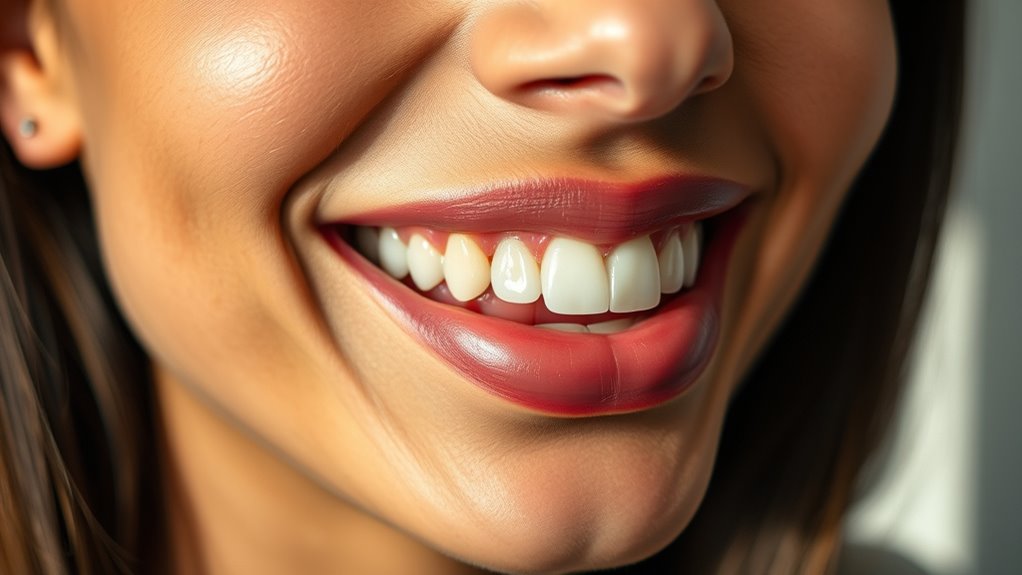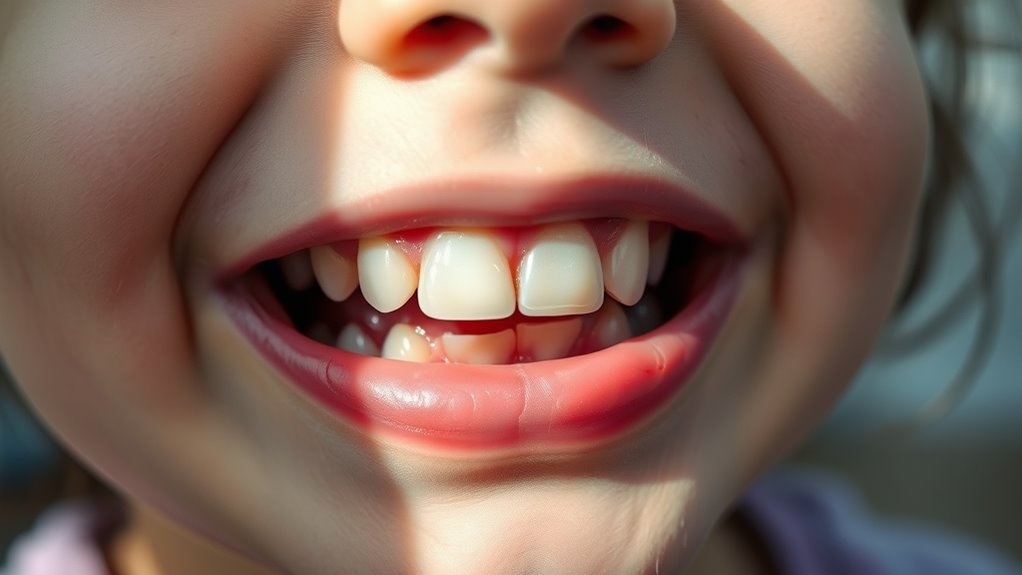You should consider orthodontic treatment if you notice crooked teeth, bite issues, jaw discomfort, or speech difficulties. Early evaluation, ideally by age 7, helps catch problems before they worsen. Signs like gaps, crowding, or thumb sucking habits also suggest it’s time to seek advice. Addressing these concerns early can lead to easier, more effective treatment. Keep exploring to discover more about when and why to see an orthodontist.
Key Takeaways
- Begin evaluation by age 7 to detect early signs of misalignment or jaw growth issues.
- Notice persistent crooked, crowded, or gapped teeth that do not improve over time.
- Experience functional problems such as speech difficulties, chewing issues, or jaw pain.
- Observe abnormal bite patterns like overbite, underbite, or crossbite affecting jaw function.
- Address oral habits like thumb sucking beyond age 3-4 that can impact dental development.
Signs Your Child Might Need Braces

If you notice your child’s teeth are crooked or crowded, it could be a sign they need braces. Misaligned teeth can affect their oral health, making it harder to clean and increasing the risk of cavities or gum disease.
Crooked or crowded teeth may indicate your child needs braces for better oral health.
Gaps between teeth that remain after age 7 may signal the need for early orthodontic treatment, which can guide proper development. An abnormal bite, like an underbite or overbite, can also indicate orthodontic issues that should be addressed promptly.
Additionally, mouth breathing or thumb sucking habits can impact alignment and suggest the need for evaluation. Proper development of teeth and jaws is essential for long-term oral health and function. Early assessment can also help identify growth patterns that influence treatment options.
If your child’s chewing or speaking is difficult or they’ve persistent dental issues, these could be signs that orthodontic treatment is necessary to ensure their long-term oral health. Recognizing early intervention can significantly improve treatment outcomes and reduce the need for more extensive procedures later on.
When Adults Should Think About Orthodontics

Many adults wonder when it’s the right time to contemplate orthodontic treatment, and the truth is, it’s never too late to improve your smile.
If you’re an adult experiencing crowding, gaps, bite issues, or jaw misalignment, now is a good time to consider orthodontic treatment. Modern options like clear aligners and ceramic braces offer discreet, comfortable solutions tailored for adults.
Knowing when to consider orthodontics depends on your personal goals—whether improving function or aesthetics. The American Association of Orthodontists recommends consulting an orthodontist to evaluate your needs, regardless of age.
Addressing these concerns early can prevent further dental issues and boost your confidence. Remember, orthodontic treatment isn’t just for kids; it’s a valuable option for adults seeking a healthier, more attractive smile.
Indicators of Bite and Alignment Problems

Bite and alignment problems often present themselves through clear physical signs that shouldn’t be ignored. If you notice irregularities like uneven teeth, difficulty biting or chewing, or speech issues, these are key orthodontic indicators. A significant overbite (more than 4 mm or 25% coverage) suggests a bite issue, while crossbites can cause uneven jaw development. Gaps that persist beyond childhood or don’t close naturally may point to teeth alignment problems. An underbite, where the lower teeth protrude past the upper, often leads to wear and jaw pain. Recognizing these signs early can prevent further complications. Here’s a quick overview:
| Indicator | Description | Potential Issue |
|---|---|---|
| Overbite | Excessive upper teeth coverage | Bite issue |
| Crossbite | Upper teeth inside lower teeth on sides | Teeth misalignment |
| Gaps between teeth | Persistent beyond childhood | Alignment problem |
| Underbite | Lower teeth protrude past upper teeth | Bite and wear issues |
| Chewing or speech difficulty | Trouble biting or talking clearly | Bite or alignment problem |
Age Milestones for Orthodontic Evaluation

You should consider having your child’s first orthodontic evaluation by age 7, as recommended by the American Association of Orthodontists. This early check helps identify potential issues like crowding or jaw growth problems before they worsen. Starting assessments at this age allows for timely interventions and better monitoring of growth and development. Additionally, understanding the self-watering plant pots concept can offer insights into how early detection and intervention can promote healthy growth. Recognizing the importance of healthy dog snacks can serve as an analogy for maintaining proper oral health in children, emphasizing preventative care from a young age. Incorporating types of divorce knowledge can also help parents navigate complex family decisions that impact a child’s well-being. Cultivating Cultural Intelligence from an early age can also help children navigate diverse social settings effectively, fostering better communication and understanding. Moreover, staying informed about innovative materials used in orthodontics can ensure children receive the most effective and comfortable treatment options.
Early Assessment Benefits
Starting orthodontic evaluations early can provide significant benefits by catching potential issues before they become more complicated. An early assessment around age 7 allows you to monitor your child’s growth, especially as their permanent teeth begin to erupt around age 6. Identifying problems like crowding, bite issues, or jaw discrepancies early can lead to simpler, less invasive treatments later. The American Association of Orthodontists recommends this evaluation to help guide proper development and ensure ideal oral health. Regular screenings during this critical period help prevent complex complications and support healthy growth patterns. Understanding early assessment benefits can also provide insights into subconscious concerns that might influence a child’s oral health and development over time. Incorporating preventive measures into early assessments can further enhance long-term oral health outcomes. Being aware of market trends and insights in orthodontics can help parents stay informed about emerging treatment options and innovations.
Growth and Development Monitoring
Have you ever wondered why regular growth and development monitoring is essential during childhood? Growth monitoring helps track your child’s child development and ensures their jaw and teeth are developing properly. Monitoring growth patterns allows your orthodontist to plan timely interventions, especially during adolescence when growth spurts can greatly influence treatment outcomes. Early assessment and ongoing growth surveillance are key to preventing future dental issues and ensuring your child’s smile develops healthily and confidently. Additionally, understanding developmental milestones can help identify potential issues early on, facilitating more effective treatment planning. Recognizing growth spurts as critical periods can further optimize the timing of orthodontic treatments for better results. Being aware of regional variation in store hours can also help families schedule their visits to the orthodontist more conveniently, ensuring consistent care. Furthermore, staying informed about growth patterns can assist in making proactive decisions about orthodontic care timing, leading to more comfortable and effective treatments.
Functional Issues That Signal Treatment

If you’re experiencing speech difficulties, chewing issues, or jaw discomfort, these could be signs you need orthodontic treatment. An abnormal bite or persistent jaw pain often indicates misaligned teeth or jaws that require correction. Addressing these functional problems early can improve your oral health and prevent more serious issues down the line. Recognizing the importance of orthodontic diagnosis and traditional practices can also improve your understanding of personal health choices and community well-being. Additionally, understanding dental treatment options can help you make informed decisions about your care. Being aware of oral health can further support timely intervention and successful treatment outcomes. Moreover, appreciating how mental wellbeing influences overall health emphasizes the importance of addressing these issues promptly.
Speech Difficulties Arising
Are speech difficulties such as lisping or unclear articulation often signals of underlying orthodontic problems? If you notice persistent speech difficulties, they could indicate malocclusion or bite issues that need attention. Addressing these early can lead to significant improvement. Early intervention helps identify structural causes and prevents long-term speech problems. You might also notice habits like mouth breathing, which can worsen speech issues and are linked to orthodontic concerns. Correcting malocclusions such as overbites, underbites, or crossbites often results in clearer speech. Keep an eye on these signs to ensure timely treatment: – Persistent lisping or unclear speech – Difficulty pronouncing certain sounds – Mouth breathing habits – Speech that worsens over time – Signs of misaligned teeth or bite Implementing orthodontic treatment can also positively impact speech clarity and function, leading to improved communication and oral health. Additionally, understanding malocclusion as an underlying cause can guide effective treatment strategies, especially since natural materials used in some orthodontic appliances can support overall oral health. Proper evaluation by an orthodontist can help identify crooked teeth alignment that might be contributing to speech issues.
Chewing and Bite Problems
Persistent chewing and bite problems often indicate underlying orthodontic issues that may require professional treatment. If you notice difficulty chewing, uneven wear on your teeth, or frequent jaw discomfort, you might be dealing with malocclusions like overbites, underbites, or crossbites.
These malocclusions can disrupt jaw alignment and lead to functional bite problems. Left untreated, they can cause increased tooth decay, gum issues, and uneven tooth wear. Recognizing early signs can facilitate timely intervention to prevent more severe complications.
Addressing bite problems through orthodontic treatment, such as braces or expanders, helps restore proper jaw function and alignment. Correcting these issues not only improves chewing efficiency but also prevents future oral health complications. Proper diagnosis and treatment planning are essential for effective correction.
Additionally, some malocclusions can be effectively managed with early intervention, which may reduce the complexity of future treatments. Understanding the relationship between jaw alignment and oral health underscores the importance of seeking professional evaluation when problems arise.
If you’re experiencing persistent bite problems, it’s a good idea to consult an orthodontist for early intervention. Proper diagnosis and treatment planning ensure the best outcomes for correcting bite issues and maintaining oral health.
Jaw Pain or Discomfort
Jaw pain or discomfort when opening or closing your mouth often signals underlying orthodontic issues that need attention. Persistent jaw pain or discomfort can result from misaligned teeth or jaw problems that orthodontic treatment can correct.
If you experience clicking, popping, or locking of your jaw (TMJ), it’s a sign your bite may be misaligned, causing jaw discomfort. Left untreated, this can worsen, leading to joint degeneration or uneven wear. Addressing these issues early can prevent future complications.
Consider orthodontic evaluation if you notice:
- Chronic jaw pain worsening over time
- Difficulty opening or closing your mouth
- Clicking or locking sounds in your jaw
- Uneven wear or chipping of teeth
- Persistent jaw discomfort not caused by other conditions
How Oral Habits Affect Orthodontic Timing

Oral habits like thumb sucking, pacifier use, and tongue thrusting can considerably influence when orthodontic treatment is needed. These habits affect jaw growth and tooth alignment, often requiring early intervention. If thumb sucking persists beyond age 3-4, it can cause open bites, overjets, and misaligned teeth, making treatment more complex later. Addressing these habits early with orthodontic appliances or behavioral modifications can reduce severity and improve outcomes. Recognizing the impact of oral habits helps you determine the right timing for intervention.
| Habit | Effect on Jaw Growth | Recommended Action |
|---|---|---|
| Thumb Sucking | Overjet, open bite | Early intervention, therapy |
| Pacifier Use | Tooth misalignment | Limit use, orthodontic appliances |
| Tongue Thrusting | Open bites, speech issues | Behavioral therapy, appliances |
| Persistent Habits | Delay in jaw development | Professional assessment |
| Age of Habit | Severity of dental issues | Timely intervention needed |
Frequently Asked Questions
When Do You Need Orthodontic Treatment?
You need orthodontic treatment when your teeth are crowded, crooked, or have gaps that don’t realign properly over time.
If you notice persistent bite issues like overbite or underbite, or if speech, chewing, or discomfort are affected, it’s time to see an orthodontist.
Early signs like thumb sucking or abnormal jaw growth also indicate that orthodontic evaluation could help.
Don’t wait if these problems are impacting your daily life.
What Are Indications for Orthodontic Treatment?
You probably notice when your smile isn’t quite as harmonious as you’d like. Indications for orthodontic treatment include crooked teeth, gaps, overbites, underbites, or crossbites that affect your bite and appearance.
If you experience difficulty chewing, speech issues, or abnormal wear patterns, these are signs it’s time to seek orthodontic care.
Early signs like thumb sucking or mouth breathing can also suggest future concerns, making timely evaluation beneficial.
Which Circumstances Indicate the Need for Orthodontic Treatment?
You should consider orthodontic treatment if you notice crooked teeth, gaps, or bite issues like overbite, underbite, or crossbite.
Also, if your baby teeth fall out early or permanent teeth come in late, it might signal a problem.
Abnormal jaw growth, facial asymmetry, or habits like mouth breathing and thumb sucking can also indicate the need for orthodontic care.
Addressing these early can improve your oral health and smile.
How Do I Know if I Need Orthodontics?
You might wonder if you need orthodontics, and honestly, if your teeth look like they’re fighting a war—protruding, crowded, or with gaps—it’s a sign.
Struggling to chew or speak clearly? Persistent thumb sucking or facial asymmetry? These are big clues.
Even if you notice discomfort or worsening dental issues, it’s time to see an orthodontist.
An early check-up can prevent future problems and straighten your smile for good.
Conclusion
If you notice your child’s teeth are crowded or their bite feels off, don’t wait—early evaluation can make a big difference. For instance, a young patient with thumb-sucking habits improved considerably with timely orthodontics, preventing future issues. Whether you’re concerned about your own smile or your child’s, paying attention to signs and acting early can save you time and discomfort later. Remember, the right moment for treatment can lead to a healthier, more confident smile.









